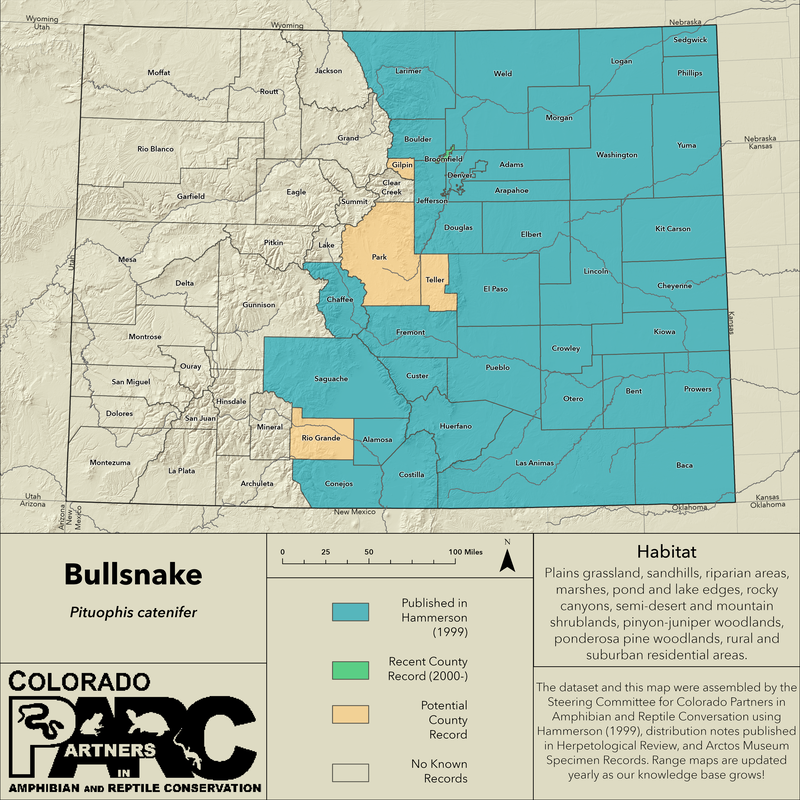|
Identification:
- Length: average length of adults around 4.6ft (1.4m) - Yellowish to cream-colored - Black, brown, or reddish-brown dorsal blotches, usually more widely spaced on the tail than the body - Dark line across the head in front of the eye and from behind the eye to the angle of the jaw - Can also be pale or dark with dark spots or mottling - Keeled central dorsal scales (Hammerson 1999) Distribution: In Colorado, Bullsnakes are found east of the Rocky Mountains, in elevations up to 8,500ft (2590m)
(Hammerson 1999) Activity: This cathemeral snake typically becomes active in the months of April and May. Males are especially active during this time as they search for females. The majority of individuals encountered after August tend to be juveniles. Activity continues throughout the summer, then starts to slow down by mid September, ending by late October. Bullsnakes spend a great deal of time underground or beneath rocks, and will occasionally utilize abandoned burrows of other animals. A good climber and burrower, the snout is used to dig and the head and neck region are used to scoop out soil from the burrow. Winter is spent in underground crevices and burrows. Communal dens may be shared with a number of other snake species. Individuals generally utilize the same den site year after year. (Hammerson 1999)
Conservation Status: One of the most common snakes in Colorado. Tolerates habitat alteration and does well in semi-agricultural landscapes and around the margins of towns.
NatureServe rank: T5 (Secure Subspecies), S5 (State Secure). |
Habitat: Habitats include plains grassland, sandhills, riparian areas, marshes, pond and lake edges, rocky canyons, semi-desert and mountain shrublands, pinyon-juniper woodlands, ponderosa pine woodlands, rural and suburban residential areas. They are especially common in grassland and open brushland. (Hammerson 1999)
Diet: A bullsnake’s diet is highly versatile. It primarily consists of rodents and small mammals, but birds, their eggs and nestlings, and occasionally lizards and insects have also been observed as prey items. A powerful constrictor, they generally kill their prey through suffocation before swallowing. When hunting in narrow burrows, they are known to kill rodents by pinning them to the wall with their bodies.
(Hammerson 1999) Defense: Defensive behavior can vary greatly between individuals. Some may lie motionless when approached, while others will respond by coiling and striking. When aroused it may hiss loudly, as well as flatten its head and vibrate its tail. The jaws may also spread, giving the head a triangular shape typical of rattlesnakes. This “mimic” behavior, along with its markings, occasionally causes these snakes to be mistaken for rattlesnakes. (Hammerson 1999)
Natural Predators: Various types of birds and mammals prey upon this snake, though in Colorado, hawks are thought to be the most significant threat to bullsnakes. Red tailed hawks and Swainson’s hawk are both known predators, along with other snakes. (Hammerson 1999)
|
Cited & Additional Resources
Hammerson G. A. 1999. Amphibians and Reptiles in Colorado. University Press Colorado, Boulder.
Stebbins, C. Robert. 1985. Western Reptiles and Amphibians 2nd ed. Houghton Mifflin Company, NewYork, New York. 189 pp.
Young, T. Mary. 2011. The Guide to Colorado Reptiles and Amphibians. Falcrum Publishing, Golden, Colorado. 136 pp.
Hammerson G. A. 1999. Amphibians and Reptiles in Colorado. University Press Colorado, Boulder.
Stebbins, C. Robert. 1985. Western Reptiles and Amphibians 2nd ed. Houghton Mifflin Company, NewYork, New York. 189 pp.
Young, T. Mary. 2011. The Guide to Colorado Reptiles and Amphibians. Falcrum Publishing, Golden, Colorado. 136 pp.
Account compiled by: Rémi Pattyn
Reviewed by:
Last Updated: 1/19/2023 by Anthony Berardi
Reviewed by:
Last Updated: 1/19/2023 by Anthony Berardi


